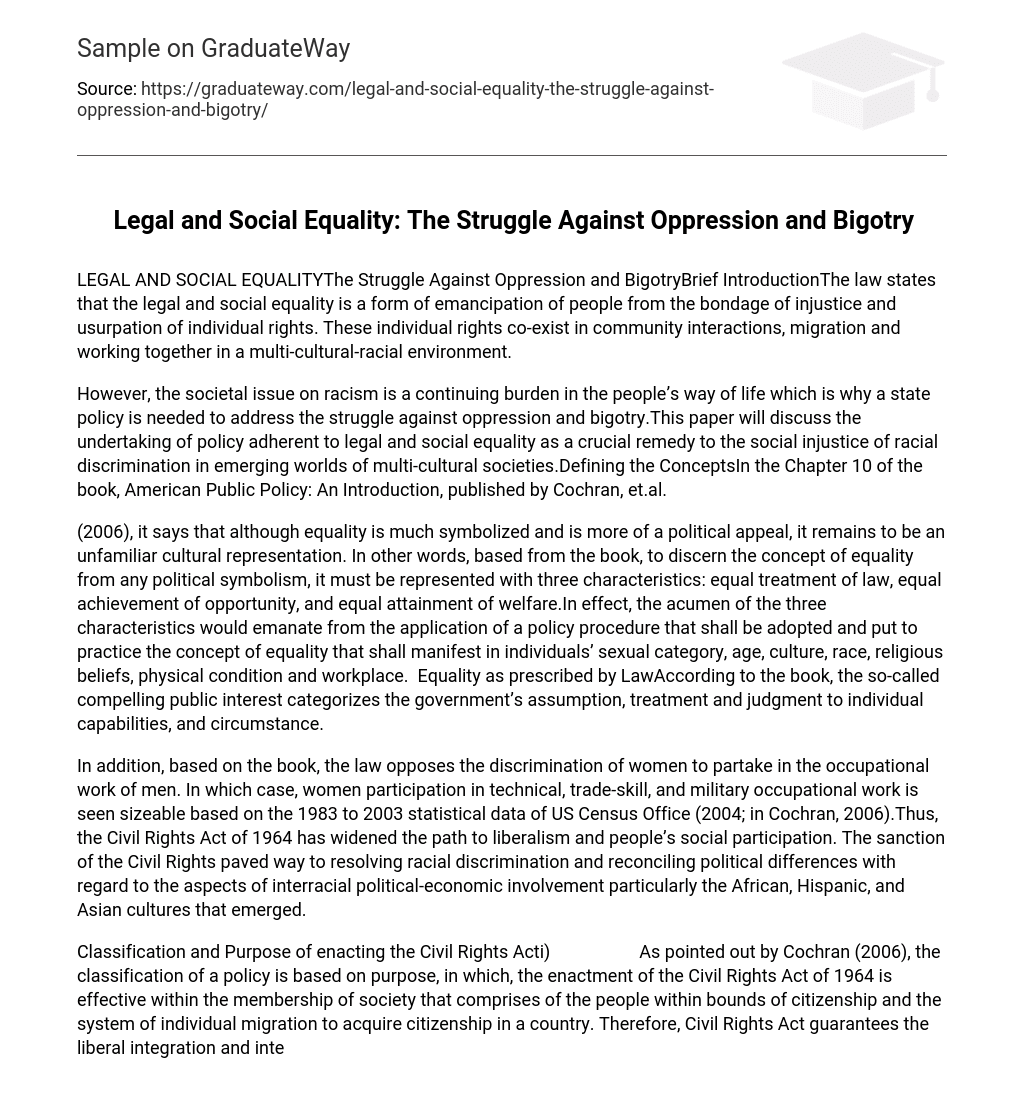Introduction
The law states that the legal and social equality is a form of emancipation of people from the bondage of injustice and usurpation of individual rights. These individual rights co-exist in community interactions, migration and working together in a multi-cultural-racial environment.
However, the societal issue on racism is a continuing burden in the people’s way of life which is why a state policy is needed to address the struggle against oppression and bigotry.This paper will discuss the undertaking of policy adherent to legal and social equality as a crucial remedy to the social injustice of racial discrimination in emerging worlds of multi-cultural societies.
Defining the Concepts
In the Chapter 10 of the book, American Public Policy: An Introduction, published by Cochran, et.al. (2006), it says that although equality is much symbolized and is more of a political appeal, it remains to be an unfamiliar cultural representation. In other words, based from the book, to discern the concept of equality from any political symbolism, it must be represented with three characteristics: equal treatment of law, equal achievement of opportunity, and equal attainment of welfare.
In effect, the acumen of the three characteristics would emanate from the application of a policy procedure that shall be adopted and put to practice the concept of equality that shall manifest in individuals’ sexual category, age, culture, race, religious beliefs, physical condition and workplace. Equality as prescribed by Law According to the book, the so-called compelling public interest categorizes the government’s assumption, treatment and judgment to individual capabilities, and circumstance.
In addition, based on the book, the law opposes the discrimination of women to partake in the occupational work of men. In which case, women participation in technical, trade-skill, and military occupational work is seen sizeable based on the 1983 to 2003 statistical data of US Census Office (2004; in Cochran, 2006).
Thus, the Civil Rights Act of 1964 has widened the path to liberalism and people’s social participation. The sanction of the Civil Rights paved way to resolving racial discrimination and reconciling political differences with regard to the aspects of interracial political-economic involvement particularly the African, Hispanic, and Asian cultures that emerged.
Classification and Purpose of enacting the Civil Rights Act
As pointed out by Cochran (2006), the classification of a policy is based on purpose, in which, the enactment of the Civil Rights Act of 1964 is effective within the membership of society that comprises of the people within bounds of citizenship and the system of individual migration to acquire citizenship in a country. Therefore, Civil Rights Act guarantees the liberal integration and interaction of people in a society without prejudice to religion-cultural-racial characteristic, color and gender.
The Civil Rights primarily envelopes social empowerment. According to the journal, The New Civil Rights Movement: Economic Empowerment, the re-direction of cultural unification to a substantive stage of economic empowerment of people in merging cultures are participative in the free enterprise far away from the limited economic activities that were brought about by racism and cultural isolation (Rodriguez, 1990).
Social empowerment relinquishes the dominant nature of racism. The society is shared with co-existing balance of political-economic power. Moreover, the enactment of the Civil Rights Act of 1964 has paved the way to create the Voting Rights Act of 1975 that provides liberal and multi-cultural participation (Rodriguez, 1990). In today’s American political process, the issue on racism has been lifted from tremendous debates.
The political race between Barak Obama and Hillary Clinton has proven political maturity from the point of view of racism. In the labor aspect, the US has continuously engaged interracial employment ranging from its domestic multi-cultural immigrants and international workforce. A long line of African, American, Hispanic, and Asian skilled workers and professionals prospects the opportunity of career advancement in management level positions in US firms.
Likewise, colleges and universities in the US have employed the perspectives of equal educational attainment within interracial learning environment. Similarly, the Protestant-Christian-Jewish religion recognizes the union of the Church through ecumenism that promotes the role of the Church in the people’s lives and the light of the world.
The Civil Rights of people emanate from the constitutional fundamentals. It is therefore the mandate of the state and its government to harness its civil and moral responsibility. One of these moral responsibilities is the enactment of state policies that provide legal guarantees that manifest social justice.Thus, the Civil Rights Act of 1964 transcend from the struggle of the dark ages, wherein oppression and bigotry is a burden of social transformation.
The Civil Rights Act of 1964 is patterned on the precedents of social empowerment through subsequent enactment of legal policies on labor, judicial standards and its processes, system of governance, political leadership, immigration and citizenship, the sanction of the state to Church hierarchy, and religious-cultural practices, to name a few.
Although it is perceived that racism still poses an issue in various individual practices, the civil rights is the effective means and the basis of seeking the legal remedies. Wherein, the Civil Rights Act of 1964 would be the applicable and remedial law to subsist social equality. Likewise, based on the journal, the General Assembly of the United Nations has affirmed the continuing validity of its Resolution No.1904 on November 20th 1963, proclaiming the elimination of all forms of racial discrimination between human beings on the ground of race, color, or ethnic origin is an offense to human dignity (Gacek, 1991). Therefore, promotion of legal and social equality is symbiotic to human rights to which emanates the strengthening of state policies towards protection and preservation of constitutional and civil rights.
Works Cited
- Cochran, Clarke E. , Mayer, Lawrence C., Carr, T.R., and Cayer, N. Joseph. “American Public Policy: An Introduction”. Thompson/Wadsworth Publishing, 8th Edition. 2006.
- Gacek, Christopher M. “Removing the Stain of the United Nations’ Zionism is Racism Resolution.” The Heritage Foundation Library. 1991.
- Rodriguez, George. “The New Civil Rights Movement: Economic Empowerment.”The Heritage Foundation Library. 1990. 28 February 2008 <http://www.heritage.org/Research/Religion/HL280.cfm>





